Outfit Yourself For Survival
We’ve all thought about what we’d do if we were stranded in the woods or caught in a city-wide disaster. It’s a fascinating thing to think about.
However, you can’t just think about what you would do. You can’t just imagine; You have to prepare.
That’s what we’re here to help you do. We’ve chosen the top 42 items that we believe are the most important survival items for a well-rounded survival kit, and we’ve included tons of tips to help you make the right decisions for your personal kit.
What Is A Survival Kit?
The simplest way to explain this is that it’s a container full of items, and it contains everything you could possibly need to survive a difficult situation.
The contents of a survival kit varies depending on the person that built it, but every survival kit is designed to help its user acquire the most basic necessities of life. An Altoids survival kit is a good example of this.
That usually means that it contains several methods for acquiring fire, water, shelter, and food, and it usually has a few tools, self-defense options, and medical items in it.
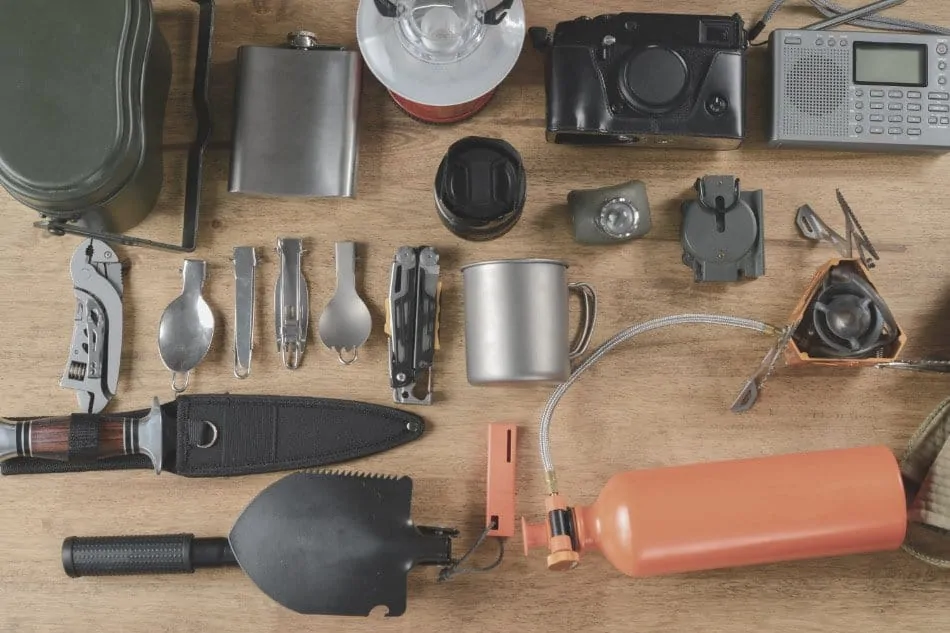
Who Needs One?
In our opinion, everyone should have a survival kit. It doesn’t matter if you spend your days lounging on a couch, or if you frequently venture out into the wilderness to escape the stress of modern life. Disaster can strike anyone at anytime.
When a disaster hits, most people find themselves relying on first response teams and government programs to stay alive. Since so many people are currently unprepared for emergencies, those services are usually slow and ineffective.
With a survival kit, you may not be guaranteed safety during a survival situation, but you’ll be a lot better off than everyone relying solely on police, firefighters, and rescue teams.
Does Size Really Matter?
Survival kits come in all shapes and sizes. You can use a duffle bag, a high-tech military backpack, or even a small Altoids tin.
While we believe your survival depends more upon your ability to adapt and the versatility of your skills, there’s no denying that a bigger edc pack will allow you to carry more useful tools, and it’ll increase your chances of surviving.
However, you should definitely take your physical fitness and skills into account when picking a pack to hold your gear in. If you can’t carry 120 pounds of gear in a 64-liter military bag, you’re better off downsizing your kit to something more manageable such as a tactical messenger bag.
Learning new skills will also allow you to do without some of the tools other survival kits rely on. For example, knowing how to use natural materials for tinder will allow you to carry a lot less synthetic tinder.
Urban VS Wilderness Survival Packs
Surviving in the concrete jungle is very different than surviving in the wilderness.
When you’re building your survival kit, you’ll have to decide which type of environment you’re most likely to end up in, and each of those environments have several different sub-types.
For instance, an urban survival kit’s contents can vary greatly depending on if it’s for your car, your house in the suburbs, or your office at work. There are a lot of different rules that you’ll have to abide by when storing or carrying your kit in those different areas.
You might not be able to carry a firearm or a knife into your workplace or on the bus, and there can be other limitations that prevent you from carrying certain tools in kits built for different areas.
The types of situations that you’re likely to find yourself in are also vastly different depending on which urban environment you’re in. Your 72hr emergency kit will also have different content to something used when going camping.
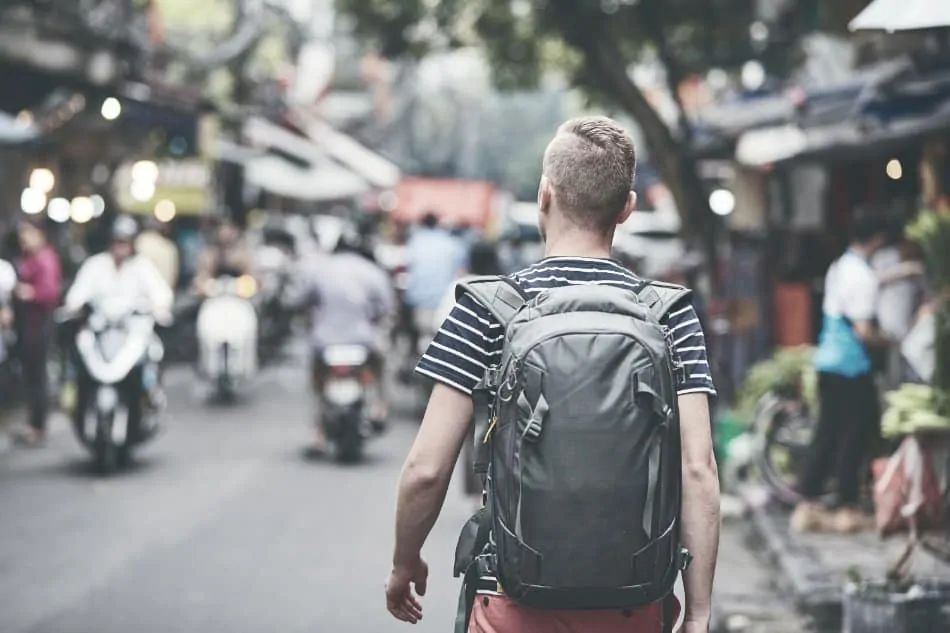
If you’re preparing an urban survival kit for your workplace, you might just want to pack the things that you’ll need to get home safely and access a bigger kit.
If you’re building a kit for your car, you have to remember that you can end up just about anywhere when a disaster strikes, and you’ll need different tools to help you work on your car, too.
The suburbs are also very different than the city. While the city’s problems will likely spill into your area if you live in the suburbs, you’re likely to have more room to move around, and you get a bit of a head start in a lot of situations. You can take that into account when building your pack for a suburban home.
Wilderness survival is entirely different as is winter survival. You can’t rely on any public services for the most part, and you don’t have access to a lot modern conveniences that remain accessible during even the worst urban disasters.
You have to prepare to purify nearly every drop of water you drink as you may not have access to any emergency water storage containers, you have to hunt or gather food, and your shelter will be a lot less sturdy than what it would be in an urban environment. So, the weather has a much greater affect on your survival, too.
Just like urban environments, there are differences in wilderness environments. Cold climates require a lot of shelter building and preparation, deserts require a constant supply of water, and the more temperate woodland climates require their own specific skills and tools.
Kit Differences Explained
Urban survival gear is very different than wilderness survival gear. In an urban setting, you have to abide by laws during times of peace, and that means you probably don’t want to carry an arsenal of large blades and axes around. They’re not that useful in the city anyways.
In the wilderness, you’ll need those tools to process wood and animals for shelter and food.
Acquiring your basic necessities also requires different tools and approaches. An urban survival kit has to rely on tools that allow the user to make the most out of what the city provides, and injuries such as gunshot wounds are much more likely. So, urban medical kits have to be outfitted with much more complex trauma kits.
A wilderness survival kit should give you the tools necessary to manipulate natural resources to your advantage. Water and fire are typically more important than having a long list of self-defense options, and you’re less likely to face medical situations that are common in the city. There are just less people around to cause serious medical issues. You also have to build a wilderness kit around surviving the elements, too, and don’t forget your survival food. They’re a lot more harsh in the wilderness.

Can Your Survival Kit Be The Same?
Your survival kits can be the same for different environments, but you’ll get the most out of your different kits if you design them for different environments.
This is because of the various differences in the types of situations you’ll face in different areas, and some tools simply aren’t useful for certain areas.
Hot VS Cold Environments
One of the most important things you should consider is the temperature of the area you’re likely to be surviving in. It may seem cool to build your bag around what you saw some YouTuber doing in Florida, but if you live in North Dakota, the majority of everything in that kit is useless to you. You have to consider your own environment.
Cold environments are very difficult to deal with. Anything that gets you wet can potentially kill you within a couple of hours, and food tends to be fairly scarce unless you can take down big game animals. Your choice of clothing is also extremely important. Not having enough layers can lead to you dying a slow and painful death.

Hot environments are the exact opposite. You will typically have to constantly seek out fresh water sources, and most of your wild food options will be smaller animals. Your clothing choice should mostly consist of items that protect you from the sun and keep you cool. Contrary to popular belief, that doesn’t mean exposing as much skin as possible. Sun burns can slow you down dramatically, and the heat on your flesh can quickly dehydrate you.
Finally, temperate environments in the woodlands tend to be a nice middle ground. Your kit for these types of environments has to be able to deal with both extreme temperatures, but the temperatures don’t get nearly as bad as they do in the other climates. You also have access to various sources of food and water.
Kit Differences Explained
You’re likely to face a lot of weather problems in both types of environments, and the weather will typically be your biggest threat.
Depending on where you are in a cold environment, you might have to face avalanches, blizzards, or in the case of the mountains, a lack of oxygen and altitude-based sicknesses. Larger animals such as bears and elk also tend to roam the more frigid environments, and you’ll need something hefty to protect yourself from them.
Water can also be an issue in very cold environments. Drinking frigid water or eating snow can kill you pretty quickly, and while it’s usually all around you, you’ll have to rely on your fire to make it safe for consumption.
The hotter areas like the tropical or desert areas produce different challenges. The desert has a lack of water, and the sun is a constant threat. However, desert nights can quickly become some of the coldest you’ve ever experienced.
The more tropical environments tend to be very hot, but there are plenty of sources of water to choose from. The biggest threats are wild animals that are vicious or poisonous, and insects that will practically eat you alive if you can’t ward them off with smoke. Making fire can also be difficult due to how moist the air is.
How Should You Pack?
It’s fairly simple. In cold environments, a large portion of your kit will have to be dedicated to building high-quality shelters, starting fires quickly, and hunting the larger animals that thrive in those environments.
In hot environments, your kit should be dedicated to finding water, staying cool, and getting out as quickly as possible. Trying to survive in the desert long term is not a good idea.
Take a look at the most coveted survival essentials to consider packing.
Recommended Survival Gear Items
The following section is entirely dedicated to our recommended survival gear list. It’s comprised of two main sections. The first will run you through our recommendations for urban survival gear, and the second will tell you what we recommend for wilderness survival gear.
Both lists are merely suggestions, and you should take your own environment, skill, and needs into account before putting any of these items into your kit. A kit is extremely personal, and you should make sure that yours works for you.
Urban Survival Kit
This is our urban survival kit list. These are 21 items that we think any urban survivalist should consider for their kit.
Anti-Theft Backpack
An anti-theft backpack isn’t exactly necessary for wilderness survival kits, but it’s a crucial part of any urban survival kit.
In an urban environment, you will most likely be competing with people who didn’t bother to put kits together before a disaster happened. In that case, they’ll look at your survival kit like it’s a buffet, and they haven’t eaten in a week.
Anti-theft backpacks are typically outfitted with locking compartments, slash guards to keep them from being cut open, and locks that allow them to be attached to poles and other objects.
Those features can keep would-be thieves from taking off with all of your most important gear.
Hydration Bladder
There aren’t a lot of streams and rivers that you can stop at to prepare a cool drink in the big city, and depending on your situation, you might end up spending large amounts of time away from your primary water source.
That’s why a hydration bladder is an absolute necessity for any urban kit. It’ll allow you to conveniently transport water anywhere you go, and you can usually access it from a straw that dangles out of your backpack.
If you buy a decent pack, a hydration bladder will likely be included with it, but you might have to search for one separately.
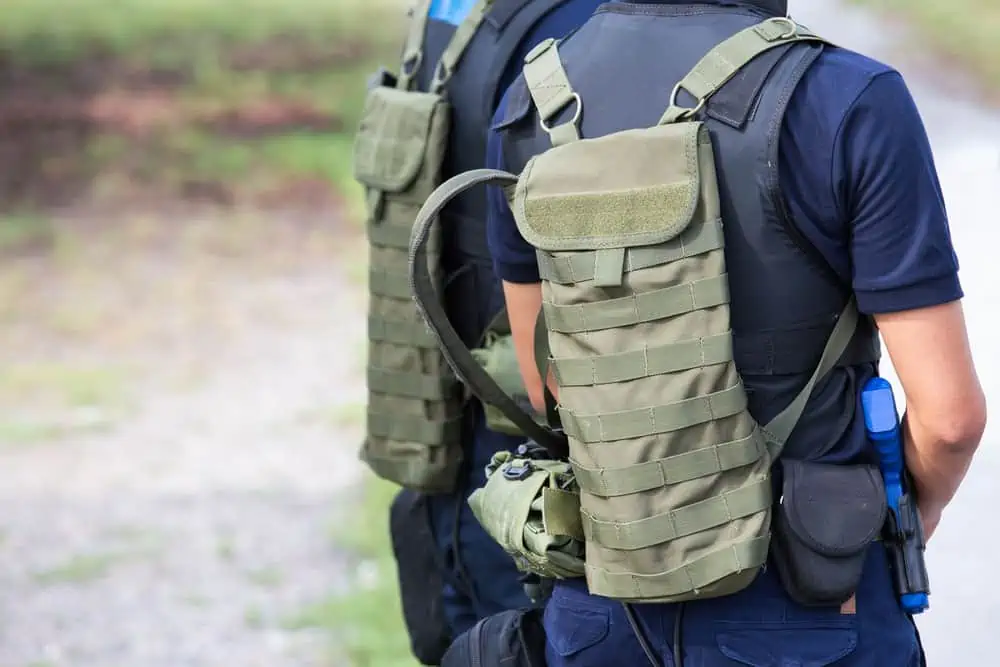
Water Purification Tablets
Boiling or distilling water isn’t always possible in a survival situation. You’ll likely be indoors for long periods of time, and both of those traditional purification methods can be dangerous indoors.
You can cause fires, or you can poison yourself with toxic gases
To prevent that, you’ll want to have a decent supply of water purification tablets to purify any water you manage to collect in the city. We suggest keeping an entire package or two of tablets to ensure that you can purify enough water to survive longer survival situations without having to resort to lighting fires indoors.
Food Rations
Stored canned foods and other common food items are pretty common in the city, but you have to consider that other people will likely be fighting over those food resources during a major emergency.
The best way to ensure that you have something to sustain you is to keep several days worth of food in your pack.
Obviously, storing several days worth of the food we all eat everyday is difficult to do with a backpack full of other stuff. So, you’ll want to rely on foods designed for survival.
Things such as MREs and dehydrated hiking meals are small, packed with calories, and more than enough to keep you going in an emergency.
We believe that it’s a good idea to keep at least three days worth of those meals in your pack. If you have a family, try to pack three days worth of food for each person in their own packs. That’ll keep you from acting like a pack mule and carrying all of the food.
Flashlight
When survival situations begin in the city, one of the first things to disappear is the electrical grid.
Wilderness survivors can often rely on their campfires to make torches or tallow candles for light. If you’re in an urban environment, we don’t suggest waving flames around like a madman. You might see where you’re going, but you’ll likely burn everything around you, too.
To prevent that, you’ll want to keep a good flashlight around. You don’t want to rely on one that you picked up at the dollar store. Make sure you shell out a decent amount of money for a high-end tactical light. I personally love the Fenix PD36r as it’s small enough to fit in any kit but bright enough to keep things visible.
Those usually have several light modes to pick from, and they’re far more reliable than your standard cheap flashlight. Considering a flashlight will probably be your only safe source of light in an urban environment, it’s easy to consider it one of the most important tools in your kit.
Some good brands to pick from are Nite Ize, Streamlight, Anker, and Fenix.
Tactical Pen
A good tactical pen functions as a writing instrument and doubles as a self-defense tool. A tactical pen is unlikely to be as effective as a fixed blade or a firearm, but it’s a lot less suspicious looking.
Pens may not seem like useful tools during disasters, but pens can come in handy if you find yourself having to sign paperwork for government relief programs, write notes, or make signs to reconnect with family members.
Lighter
Fire isn’t safe in some urban survival environments, but you’ll still rely on it. A good lighter or fire piston is the best way to ensure that you can light a camp stove or candles when you need to.
We would usually recommend ferrocium rods to start fires, but they can be fairly dangerous in an urban environment. If you’re cooking in your home, you probably don’t want to shower hundreds of hot sparks across your kitchen or wherever you’re cooking.
A good Bic or windproof lighter like a Zippo can give you the fire you need in a controlled and safe manner. If you go with a Zippo-style lighter, you’ll want to make sure to pack some spare lighter fluid with it. It won’t be very useful without it.
Multi-Tool
Survival knives and axes might be the kings of the wilderness, but a high-quality multi-tool is our recommendation for urban environments.
You’re much more likely to need the little tools and gadgets on a multi-tool when you’re surviving in the city, and the lack of a large knife blade isn’t too much of a concern since you won’t be splitting wood or building natural shelters.
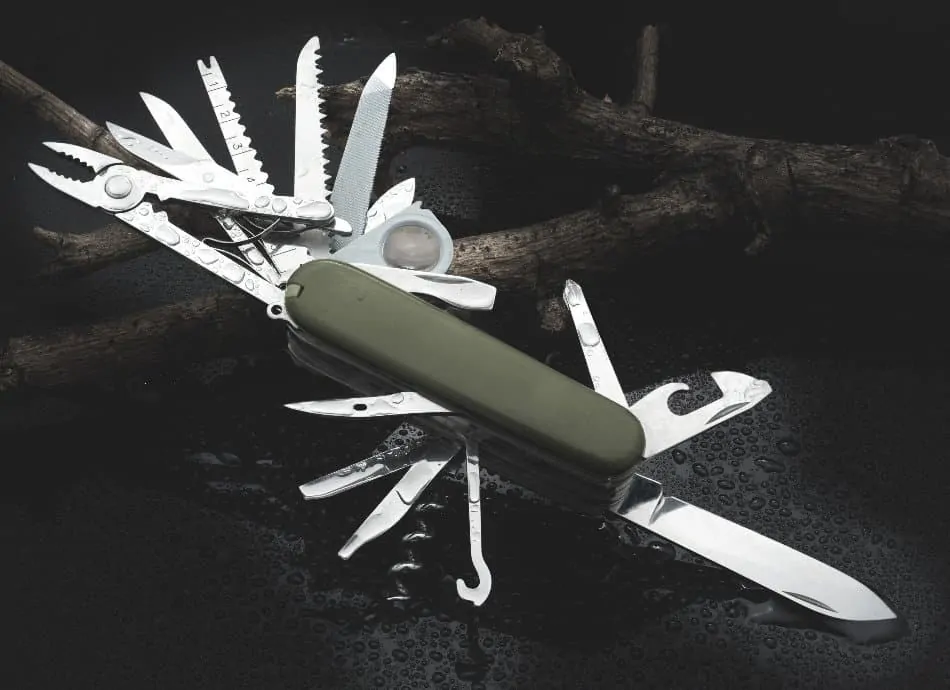
The small screwdrivers, can openers, files, and other tools on a multi-tool can help you work with the man-made materials around you. You can use them to repair crucial pieces of equipment, cut through fencing, open food cans, or build things that can help you survive.
As an added bonus, pretty much all multi-tools have knife blades on them. So, you’ll still have a knife to cut things with.
However, we suggest buying a high-quality multi-tool. The lower quality ones usually don’t perform very well, and your multi-tool will likely be your best friend in an emergency. Make sure it’s a good one.
Mobile Phone
A cellular phone will most likely lose its ability to make calls or access the internet if a big enough disaster strikes, but not every survival situation is on the same scale as a societal collapse. Sometimes, you’re just trying to get help after a shooting or car wreck. Always have a spare phone in your survival kit.
If the cell towers are still working, you can use your phone’s GPS to get where you’re going, and you can call for help in an emergency.
Even if the cell towers are rendered useless, a mobile phone still has some useful features. You can usually download maps of a specific area to your phone’s SD card, and that will allow you to access those maps when you don’t have internet access.
You can also use your phone’s battery to start a fire if things are bad enough. By shorting the battery next to some tinder, you’ll be able to start a fire very quickly. However, you also have to worry about the battery exploding. So, do that at your own risk.
Slingshot
A slingshot may not be as powerful as a rifle, but it’s a useful piece of equipment in an urban setting.
A decent slingshot is capable of taking down squirrels for food, and that’s pretty much all the wildlife you’re going to see in a city.
However, slingshots can also be used for self-defense. They may not be a good choice for a firefight, but if a stray dog or aggressive person tries to take a chunk out of you, you can bet that a rock between the eyes will make them think twice.
Some of the best slingshots can send ball bearings through sheet metal or ballistic gel. So, the right one can give you a lot of firepower without having to worry about complex bullets.
Spare Batteries
Spare batteries are an absolute necessity for an urban kit. Wilderness survivors can often rely on primitive skills to make it without many electronic devices, but an urban setting requires the use of flashlights, phones, radios, and other things that rely on batteries.
You won’t be able to skip down the street to your local Walmart to buy batteries for your electronics. You’ll have to have a decent stockpile ahead of time.
However, you can’t just buy a few packs of batteries, throw them in your bag, and forget about them. You have to ensure that you store them properly. We suggest buying a battery storage case.
A case will allow you to keep your batteries from spilling acid everywhere, and it’ll help keep your batteries from dying before you need them.
Power Bank
A power bank is useful for all of your rechargeable devices. It can supply power to your phone, tablet, or any other rechargeable device that you may have. Anker makes some very high-quality models, but you can get a decent option in just about any price range.
The one thing that you need to worry about is keeping the power bank charged. Just like any electronic device, a power bank’s power reserve depletes over time. So, you’ll want to take your bank out of your backpack for a quick charging every few days.
If you don’t, it’ll likely be dead when you need it during an emergency, and it’ll just be extra weight in your bag.
First Aid Kit
Emergency first aid kits are necessary in any survival kit. If you get a deep cut or a broken finger, you can’t expect to have a hospital fix it during a major disaster.
Survival first aid kits are meant to treat major trauma or serious health issues. You want to add basic items like bandages and Tylenol, but the purpose of a survival first aid kit is to handle much worse conditions.
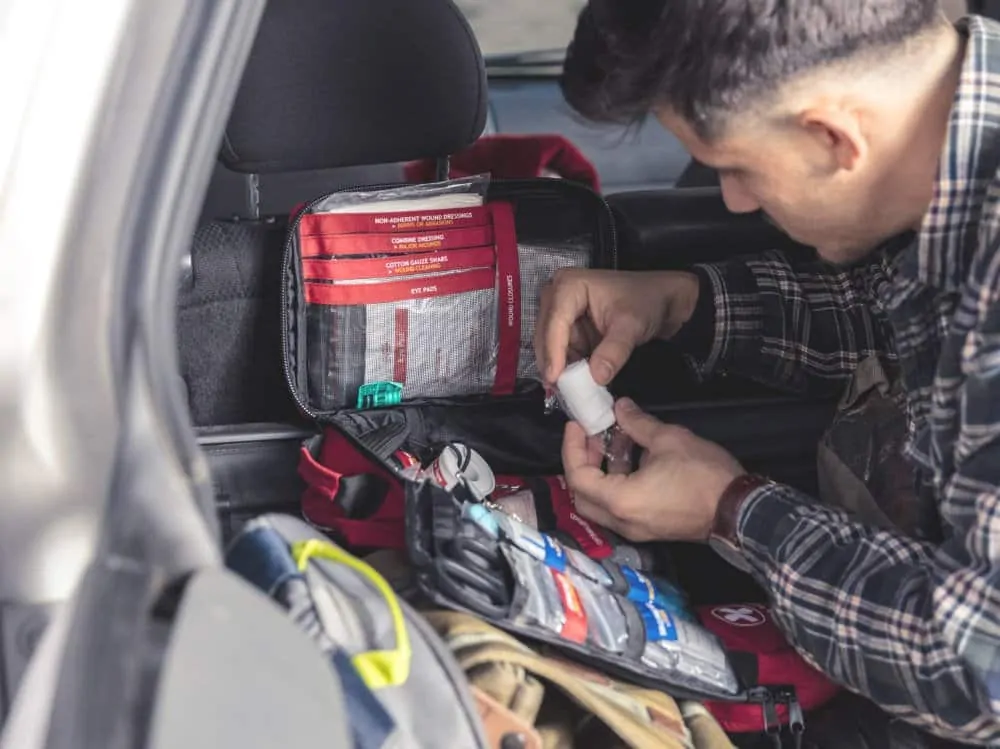
You’ll most likely want gauze, medical tape, antiseptic, burn cream, and maybe even Halo seals to help with penetrating chest wounds. Tourniquets and splints are also important to have.
However, don’t mess around with things that you’re completely unqualified to use. It might seem like a good idea to purchase hospital-grade medical gear, but improperly using that gear can lead to you making a medical situation much worse than it should be.
We recommend signing up for a course that teaches you how to use the more complicated pieces of medical equipment.
Rain Poncho
Getting a little wet on a rainy day isn’t usually anything to worry about. You’re usually just a short walk away from a way to dry off and get warm. However, that changes when a disaster occurs. Something as simple as a quick downpour can leave you suffering of hypothermia.
For that reason, you want to keep a rain poncho in your bag at all times. It doesn’t have to be a fancy poncho, but it needs to be durable and capable of keeping you dry.
That will allow you to traverse the city streets in the rain without any major consequences.
We recommend getting one that doesn’t take up a lot of space in your pack, and you should also keep it in a spot that you can access within seconds. You don’t want to fumble around for five minutes trying to find your poncho. You’ll likely be soaked before you get it on, and that defeats the purpose of having it in the first place.
Bivy Sleeping Bag
Do you like sleeping on your comfortable mattress every night? That’s likely to disappear when the city becomes chaotic. If you decide to flee, you’ll have to leave that mattress behind.
When you’re on the move in the city, you might end up sleeping in some really unexpected spots, and carrying enough blankets to stay warm is impractical. A bivy bag can solve that problem.
A bivy-style sleeping bag is a compact sleeping bag that fits into a small sack. When you want to go to bed, you just pull it out and hop in.
They’re made to be extremely warm and easy to carry. So, they can take care of your sleeping needs without any other equipment.
Hand Sanitizer
The city is gross, and it’ll get a lot more disgusting when thousands of people are left without proper bathrooms, sinks, and other hygiene commodities. You also have to consider that a lot of people will be exposed to blood and bodily fluids due to injuries.
You don’t want to go around touching things that other people have touched in that type of situation. That’s especially true if you don’t have anything to clean yourself with.
You can solve that by simply carrying a bottle of hand sanitizer with you. If you are forced to touch something that can spread disease or make you sick, you can clean yourself immediately, and that reduces your chances of coming down with anything.
We recommend getting a large bottle of the 99 percent alcohol variety. The weaker stuff is less likely to sanitize your skin.
Whistle
A proper whistle is under appreciated by most preppers. It’ll allow you to signal your friends and family, and you can get the attention of rescue teams with one.
It’s best to have a whistle around your neck or strapped to your bag. Whistles are very light, and you’ll want to access yours quickly when you need it.
Don’t buy a cheap one that barely squeaks when you blow it. Get one that would make your old gym teacher envious. In a survival situation, you’ll have to stand out from everyone else who is making a racket.
Survival Dust Respirator Mask
A proper respirator mask can save your life. If you were around during 9/11, you know how hard it can be to breathe when a building collapses, and the city is filled with buildings that can become damaged during major disasters.
A lot of people won’t have a proper respirator on hand, but it’s important for you to secure one as a prepper. Dust inhalation can cause you to suffocate, and you won’t have to worry about surviving anything if that happens.
Spare Cash
Spare cash takes up barely any room, and it can be extremely useful in a lot of survival situations.
In a large-scale disaster such as a collapse, some people may be willing to part with items that you need from them if you can butter them up with a few bucks. It’ll also help you out if you decide to leave the area. Being without cash in an area unaffected by the disaster can make even the simplest of things more difficult to do.
If you’re affected by a more personal experience such as getting lost while traveling, getting injured, or having your car stolen, a little bit of spare cash can get you a ride, a phone call, or any other basic service you may need.
We suggest carrying no less than $20, and you probably shouldn’t carry more than $100. You want to have enough to give yourself a little boost, but you don’t want to become a target by dragging your entire savings account around.
Lock Pick Set
Picking locks may seem like a skill for thieves and other nefarious people, but it can be a very legitimate skill in an urban survival situation.
Think about it a bit. Are you going to be able to call a locksmith to unlock your house or a safe with your gun in it? We highly doubt it.
Being able to get into locked safes or doors can grant you access to the things you need to survive, and it’s important to carry at least a basic lock picking set with you.
It’s not too difficult to use a pick. The Bagota-style pick simply requires you to rake it in and out of a keyhole until it pops open.
Concealed Carry For Protection
It’s a sad fact that defending yourself can become a necessity. In a situation where thousands of people are struggling to survive, the likelihood of you being attacked is increased dramatically.
You don’t need to pack a 12-gauge shotgun into your survival kit, but a small and efficient handgun can mean the difference between living and dying.
You should consider the caliber of a weapon’s required ammunition before you settle on a specific model. Gun stores won’t be open. So, you’ll have to find or reload your own ammo.
Guns that use 9mm or .45 ammunition are ideal because most civilians that own guns will have that ammo to trade or use against you. Obviously, the first reason is preferable.
Wilderness Survival Kit
This is our wilderness survival kit list. There are 21 items that we believe belong in every wilderness survival kit.
Hunting Or Wilderness Backpack
A hunting or wilderness backpack is usually going to be large, filled with organization pockets, and outfitted with a hydration bladder.
These bags are designed to hold a lot of heavy-duty gear, and they’re usually protected by a waterproof coating to help your gear stay dry in the rain.
Water Filtration
Water filtration is even more important in a wilderness survival situation. Our urban survival kit list mentioned how urban survivalists can scavenge purified water from a variety of things in their house. So, they’re not as reliant on natural water sources.
Wilderness survivors don’t have that luxury. Nearly every drop of water you can use in the wilderness must be purified, or you can end up with a serious illness.
We suggest bringing at least two different methods of purification with you. That’s not including the ability to boil or distill your water with a fire.
The best options are survival straws and water purification tablets. They both work quickly, and they’re reliable when boiling isn’t an option.
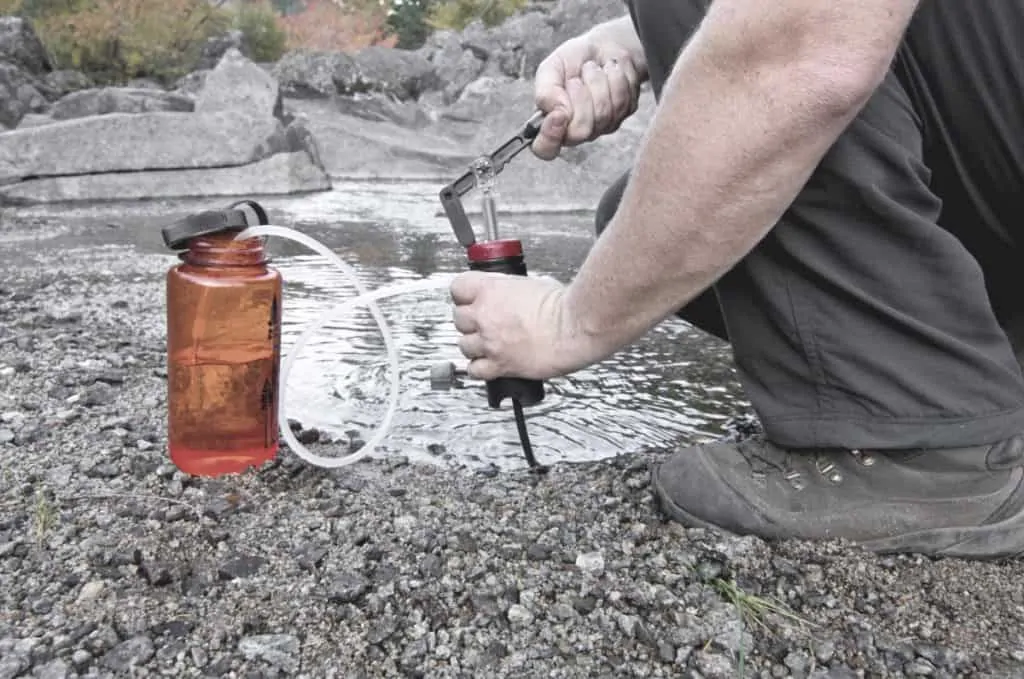
Meals Ready To Eat (MRE)
MREs have been a staple in the prepping community since it first started. MRE refers to the meals that soldiers eat while they’re in the field. They typically consist of a full entree, a desert, a drink, and a few items to help the soldier eat. They can be heated up by pouring water in their sealed bag, or they can be eaten cold.
The problem with military MREs is that they’re expensive. They also have way more calories than what the average person could even hope to use within a single day.
Luckily, there are civilian versions available that are cheap, realistically-balanced, and still capable of being stored for long periods of time.
Try a few different meal varieties to see what you like, and add your favorites to your bag. We recommend bringing three days worth of food with you in your pack.
Tactical Flashlight
The wilderness may be a prime spot to utilize primitive lighting such as torches and other old-fashioned light sources, but you still want a flashlight.
A good flashlight is key, but we recommend getting one that requires batteries. The rechargeable ones are likely to die before you find yourself in a survival situation, and you can always store spare batteries in your pack without taking up much room.
Medical Kit
Your medical kit should be outfitted to handle broken limbs, major cuts, infections, and burns. You’ll also want to pack some stuff to deal with stomach issues. All kinds of things can happen when your diet suddenly consists of wild game and gathered berries.
Unlike urban medical kits, you don’t really need to worry about plugging gunshot wounds or handling stab wounds. You’re unlikely to deal with those injuries in the wilderness.
Solar Generator
Before you read that title and get any weird ideas, you should know that you’re not expected to drag an entire generator everywhere you go. We’re talking about a personal solar panel that fits on your backpack or folds out on the ground.
Obviously, you won’t be able to plug your phone, flashlight, or other electronic items into an outlet in the middle of the woods. A solar panel will allow you to charge those items reliably in the wilderness.
However, they rely on the sun, and the cheap ones tend to be a bit low-quality. If you want to make sure your electronic device is charged in the woods, shell out a few extra bucks for a premium solar panel.
Folding Shovel
A folding shovel is a great item to have, but it’s not an absolute necessity. So, we only recommend adding this hunk of steel to your kit if you have the extra room.
You can use a folding shovel to dig holes for relieving yourself in, or you can use it to build certain shelters or traps. However, you can do the same things with your fixed blade in a pinch. You’ll just dull the edge of your knife very quickly.

Tarp Shelter
Does spending hours building a rudimentary shelter from leaves, dirt, and sticks sound like a lot of work for a rather unimpressive shelter? If so, you should pack a good tarp.
A tarp can be put up within 15 minutes if you’re good at it, and it’s a lot more likely to keep you warm and dry than a bunch of piled up leaves.
Go for a large oil tarp if you want the best shelter possible. The large surface will give you more options when you’re building your shelter, and the oil coating will keep it from deteriorating due to water damage. They can outlast you a lot of the time.
Paracord
Cordage isn’t something to skimp on when you’re building your kit. You’ll need it for shelters, traps, and all sorts of other things. If you want the best cordage possible, we recommend buying a decent amount of paracord.
Paracord can be cut and gutted to supply you with thin strands and a woven sheath. Each piece is extremely useful, and you can tie the pieces together to increase the length of your cordage.
However, you have to buy good paracord. A lot of manufacturers will market paracord with only three or four strands as 550 cord. That cordage isn’t as strong as the 550 the military uses. What’s worse is that those manufacturers sometimes label that inferior stuff as 550. So, always buy your cordage from a respected supplier, and ask to see an opened sample if it’s possible to do so. There should be seven strands of inner cordage in high-quality 550 cord.
Sleeping Bag
You’ll be away from your comfy bed when you’re in a wilderness survival situation. You can either carry a sleeping bag, or you can face the dangers that come with sleeping directly on the ground.
A good sleeping bag can either fit in your bag or be attached to the outside of your bag. Which style you use is up to you. Make sure you buy one that has plenty of insulation, though. A thin sleeping bag won’t keep you warm.
Map, Compass, GPS
Since you can’t rely on public services to save you in a lot of wilderness emergencies, you’ll have to get yourself out of the wilderness to find help. That requires a few navigation tools.
A map of the area you’re in will give you a good idea of what the terrain looks like, and a compass will help you follow that map without getting lost. Don’t buy a cheap compass. The wilderness is vast, and small inaccuracies in your compass can leave you miles off track.
GPS is the most accurate way to find your way out of the wilderness, but it has a few downsides. Heavy foliage in the forest’s canopy can block GPS signals, and all GPS systems are electronic. So, they die when they run out of battery power.
It’s good to bring all three along. You can use your GPS if it’s available, but you’ll still have a map and compass to fall back on.
Signal Mirror
A signal mirror is primarily used to get people’s attention. You can shine it up at helicopters that fly by, or you can flash it at distant hikers if you see any. It’s not difficult to do, and it’s really unnecessary to give you a detailed guide on how to use it. Just angle it at the sun, and adjust it until light aims at what you want to signal.
A less-known use for a signal mirror is as a fire starting implement. You can concentrate sunlight onto very dry tinder to catch it on fire. It’s easier to use a lighter or another tool, but a mirror can help you out in a pinch.
Survival Whistle
A whistle serves the same purpose as a signal mirror. It’s there to get the attention of people that are too far away for you to simply yell at them. You hold it, blow into it, and hope the other person hears it.
It can also be used to keep track of people that might be surviving with you. If you get separated, a whistle can help you find your group again.
Firestarter
Bring several ways to make fire. Weather conditions, materials available, and several other factors impact your ability to make fire, and fire is a necessity in the wild. It is very likely that you’ll come across a situation where your preferred method is rendered useless.
We recommend bringing at least three different tools to help you start a fire. Obviously, your first choice should be a lighter. It’s the easiest too to use, and it’s pretty much the only tool that makes a flame on its own.
Second, a large ferrocium rod is a great choice. It doesn’t create flames like a lighter, but it does shower hundreds of hot sparks all over the place. When you place tinder underneath your rod, it’ll easily catch the tinder on fire when it’s scraped.
Finally, our preferred backup option is a fire piston. A fire piston utilizes friction to make small amounts of tinder smolder, and then the smoldering tinder can be added to a larger bundle of tinder to create flames.
It’s easy to use a piston. You just put your tinder in the small section designated on the piston, slam the piston shut, and dump the smoldering bits of tinder into a larger bundle. This is our least preferred method of the three because it’s not reliable in environments where dry tinder isn’t available.
Tinder For Fire
Your fire tools are useless if you don’t have access to dry tinder. If you’ve practiced bushcraft skills, you probably know how to find dry tinder in the most difficult environments, but it’s still good to have some already on you.
Small tinder packages are available in nearly every big box store now. They resemble cubes of cotton, and they’re coated with a petroleum-based chemical to keep them lit for a long time. You can also buy cans of camp stove fuel, but those are a little bulkier.
If you’re strapped for cash, you can simply gather dry tinder from nature, and you can put that in your pack. Dry plant fibers, cotton, and other similar materials will work just fine.
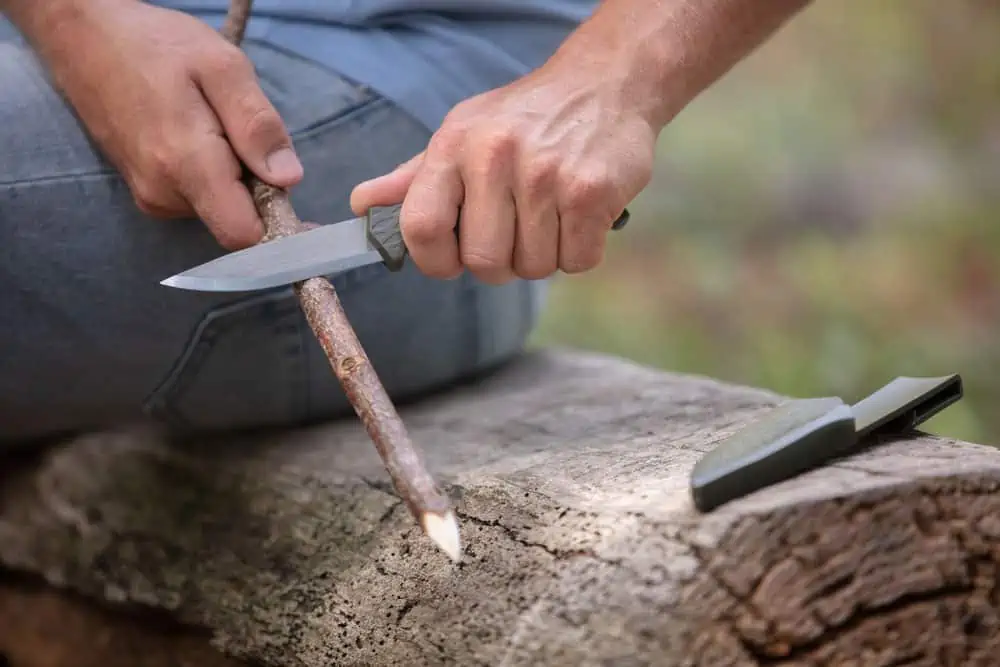
Cookware And Utensils
You have to be able to cook your food once you hunt or gather it. To do that, you’ll want a portable cooking set.
Since this entry is for our wilderness survival kit list, we don’t think it’s overkill to tell you to bring heavier pots and pans. Something like a large cast iron skillet can be used on an open fire, a lot of different things can be cooked on it. A pot with thick walls and a lid is also a necessity for boiling water or making soups.
If you can fit a pot in your bag, try to get one with a wire hanger. That will allow you to hang the pot over a fire, and you can control its temperature a lot better.
Folding Saw
A good folding saw will help you conserve energy when it’s time to gather limbs for a shelter or firewood. It’s a lot easier to saw limbs off a tree than it is to swing an ax around.
A Bahco Laplander is probably your best option for a folding saw. It’s compact, sharp, and it cuts very efficiently. There are cheaper options, but it’s not worth buying something a few bucks cheaper that doesn’t work.
Fixed Blade Knife
A fixed blade knife is the most important tool you’ll have in your wilderness kit. It’ll skin game, build shelters, chop firewood, and many other things that you’ll need to have done to survive.
Since it’s such an important tool, you don’t want to cut corners when you buy yours. A high-carbon blade isn’t a must, but it will help you out a lot. It can be used to start fires if you find a flint to smack it with, and its edge will stay sharp much longer than the edge on a stainless knife.
We recommend buying one that is at least seven inches in length. That’s enough to baton most logs that you actually need to split, and it’s large enough to process even the largest animals you might hunt.
We also recommend bringing multiple backup blades. You don’t have to bring several large fixed blades, but having a folder or two will give you a few more options.
Fishing Line With Hooks
Fishing without a rod and reel can be a bit weird at first, but it can save your life. You can easily bring a few hundred feet of strong fishing line without taking up a lot of room, and packing a small tin of hooks will keep you from having to fashion your own.
We recommend bringing 20 or 25-pound fishing line. If you do, it can double as relatively strong cordage, and it’s unlikely to snap if you manage to hook into something bigger than a sunfish.
Bringing some basic J-hooks is a great idea. You don’t need anything complicated.
Finally, a bobber or two can help you out if you have the room for it in your bag. If not, you can fashion one from any natural material that floats.
You can use this equipment with your hands, or you can fashion a cane pole out of a suitable stick.
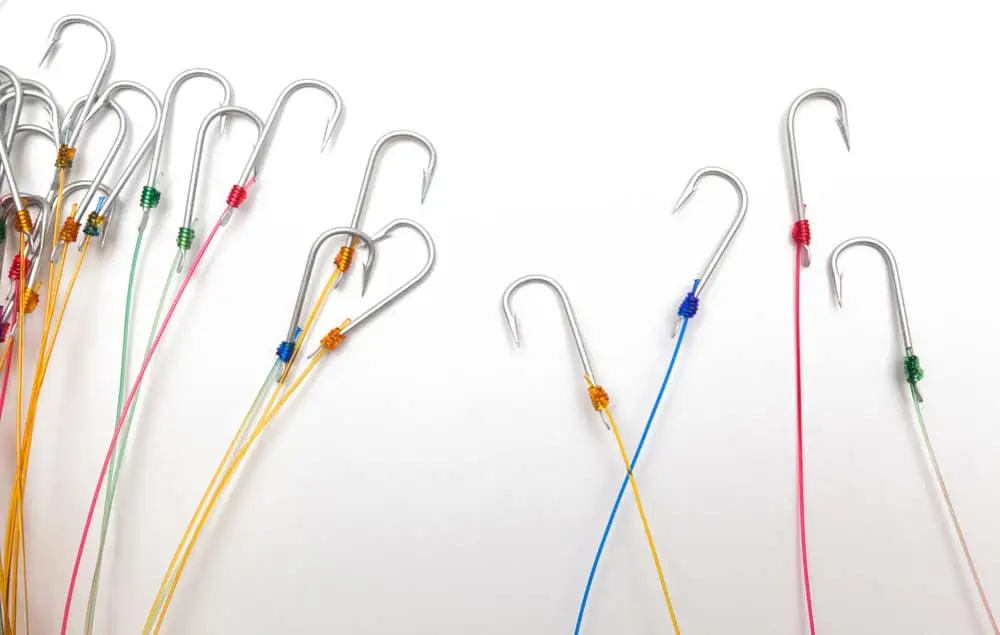
Proper Clothing
The clothing you need to have with you is dependent on your environment. If you’re packing spare clothes for a cold environment, you’ll obviously want a thick jacket, long-sleeved shirts, and warm pants. A few pairs of long johns are also great to pack with you.
If you’re in a hotter environment, try to pack loose-fitting clothes that are designed to wick sweat away from your skin. If you’re in the desert, don’t forget to pack a pair of clothes for nighttime. You might be struggling with heat during the day, but the nighttime can easily feel as if you’re in a frigid environment.
Crossbow For Hunting
A rifle or a shotgun is nice, but a crossbow is more suitable for wilderness survival. You’re unlikely to need the firepower that a firearm provides, and there probably won’t be other people trying to shoot you. A crossbow will do just fine.
There are a few things you need to think about before picking a crossbow. First, you need enough firepower to take down decent animals such as deer or boars, but you don’t want a crossbow that requires a ton of energy to cock.
Crossbows that are rated to exert 180 pounds or more of pressure can be difficult for seasoned hunters to cock during normal situations. Now, imagine being starved, dehydrated, and exhausted. It’ll be awfully difficult to use that heavy-duty crossbow.
We recommend buying one that’s rated about 80-160 pounds. That’s still quite powerful, and it should be manageable even when you’re exhausted.
For The Car
Your car survival kit requires some special considerations. You likely drive your car through many different environments throughout your week, and you can end up stranded in any of those environments.
So, it’s good to have the basics covered, and it’s smart to have a few things that can fix your car up, too. Our top suggestions for a car survival gear list will be added to this article in the near future so feel free to visit GearDisciple again.
Final Thoughts
We’ve highlighted the most important survival items for a variety of survival kits in this article. However, you shouldn’t take it as a list of must-have items. Go over the different lists, and figure out what you need for your own situation.
Survival isn’t something that usually goes our way. So, you want to have a kit that can handle nearly any problem you come across. An unbalanced kit can easily leave your options limited in several areas.
Finally, make use of your own skills as much as possible. Try to learn to do new things that can help you survive every day. If you have more skills, you need less stuff.
I’m Nebojša, a seasoned digital marketing professional with over 15 years of experience. My writing covers a diverse range of topics, from technology and gaming to app development and automobiles, all while delving into the intricacies of SEO optimization. Beyond the digital realm, I find solace in nature, inherited from my father’s love for the outdoors. His passion for hunting has influenced me, adding another layer to my appreciation for the natural world.